Estimates of the Surface Magnetic Field Strength of Radio Pulsars
Abstract
1. Introduction
- Short-periodic pulsars, including millisecond pulsars ();
- Middle-periodic pulsars ();
- Long-periodic pulsars ().
2. Methods
2.1. Estimation of -Parameter
2.2. Data Selection and Evaluation of
- Objects with known spin period ;
- Exclusion of objects with ;
- Known spin-down rate ;
- Known parameter.
3. Results
4. Discussion
Supplementary Materials
Author Contributions
Funding
Acknowledgments
Conflicts of Interest
Abbreviations
| ATNF | Australia Telescope National Facility |
| AXP | Anomalous X-ray pulsar |
| deg | Degree (unit) |
| G | Gauss (unit) |
| MDR | Magnetic Dipole Radiation |
| ms | Millisecond (unit) |
| MSP | Millisecond pulsar |
| NS | Neutron star |
| SGR | Soft gamma-repeater |
| s | Second (unit) |
| s/s | Seconds per second (unit) |
| yr | Year (unit) |
| 1 | https://www.atnf.csiro.au/people/pulsar/psrcat/ (accessed on 2 June 2023). |
References
- Lyne, A.; Graham-Smith, F. Pulsar Astronomy; Cambridge University Press: Cambridge, UK, 2012. [Google Scholar]
- Manchester, R.N.; Hobbs, G.B.; Teoh, A.; Hobbs, M. The Australia Telescope National Facility Pulsar Catalogue. Astron. J. 2005, 129, 1993–2006. [Google Scholar] [CrossRef]
- Tan, C.M.; Bassa, C.G.; Cooper, S.; Dijkema, T.J.; Esposito, P.; Hessels, J.W.T.; Kondratiev, V.I.; Kramer, M.; Michilli, D.; Sanidas, S.; et al. LOFAR Discovery of a 23.5 s Radio Pulsar. Astrophys. J. 2018, 866, 54. [Google Scholar] [CrossRef]
- Malov, I.F.; Marozava, H.P. On Braking Mechanisms in Radio Pulsars. Astron. Rep. 2022, 66, 25–31. [Google Scholar] [CrossRef]
- Ken’ko, Z.V.; Malov, I.F. Evolution of the angles between magnetic moments and rotation axes in radio pulsars. Mon. Not. R. Astron. Soc. 2023, 522, 1826–1842. [Google Scholar] [CrossRef]
- Gunn, J.E.; Ostriker, J.P. Magnetic Dipole Radiation from Pulsars. Nature 1969, 221, 454–456. [Google Scholar] [CrossRef]
- Pacini, F. The Nature of Pulsar Radiation. Nature 1970, 226, 622–624. [Google Scholar] [CrossRef] [PubMed]
- Kuz’min, D.K.; Dagkesamanskaya, I.M. Evaluation of the angles of magnetic axis relative to rotation axis of the Pulsars. Astron. Lett. 1983, 9, 149–154. [Google Scholar]
- Lyne, A.G.; Manchester, R.N. The shape of pulsar radio beams. Mon. Not. R. Astron. Soc. 1988, 234, 477–508. [Google Scholar] [CrossRef]
- Malov, I.F. Angle Between the Magnetic Field and the Rotation Axis in Pulsars. Sov. Astron. 1990, 34, 189. [Google Scholar]
- Ken’ko, Z.V.; Malov, I.F. Comparison of the Angles between the Magnetic Moment and Rotation Axis for Two Groups of Radio Pulsars. Astron. Rep. 2022, 66, 669–692. [Google Scholar] [CrossRef]
- Igoshev, A.P.; Popov, S.B.; Hollerbach, R. Evolution of Neutron Star Magnetic Fields. Universe 2021, 7, 351. [Google Scholar] [CrossRef]
- Xie, Y.; Zhang, S.N. Rotational behaviors and magnetic field evolution of radio pulsars. Astron. Nachrichten 2014, 335, 775. [Google Scholar] [CrossRef]
- Portegies Zwart, S.F.; Van den Heuvel, E.P.J. The origin of single radio pulsars. New Astron. 1999, 4, 355–363. [Google Scholar] [CrossRef]
- Lipunov, V.M. Astrophysics of Neutron Stars; Springer: Berlin/Heidelberg, Germany; New York, NY, USA, 1992. [Google Scholar]
- Goldreich, P.; Julian, W.H. Pulsar Electrodynamics. Astrophys. J. 1969, 157, 869. [Google Scholar] [CrossRef]
- Manchester, R.N.; Hobbs, G.B.; Teoh, A.; Hobbs, M. VizieR Online Data Catalog: ATNF Pulsar Catalogue (Manchester+, 2005); VizieR Online Data Catalog: 2016; p. B/psr. Available online: https://ui.adsabs.harvard.edu/abs/2016yCat....102034M/abstract (accessed on 1 June 2023).
- Rahaman, S.M.; Mitra, D.; Melikidze, G.I.; Lakoba, T. Pulsar radio emission mechanism—II. On the origin of relativistic Langmuir solitons in pulsar plasma. Mon. Not. R. Astron. Soc. 2022, 516, 3715–3727. [Google Scholar] [CrossRef]
- Pilia, M.; Hessels, J.W.T.; Stappers, B.W.; Kondratiev, V.I.; Kramer, M.; van Leeuwen, J.; Weltevrede, P.; Lyne, A.G.; Zagkouris, K.; Hassall, T.E.; et al. Wide-band, low-frequency pulse profiles of 100 radio pulsars with LOFAR. Astron. Astrophys. 2016, 586, A92. [Google Scholar] [CrossRef]
- Philippov, A.; Tchekhovskoy, A.; Li, J.G. Time evolution of pulsar obliquity angle from 3D simulations of magnetospheres. Mon. Not. R. Astron. Soc. 2014, 441, 1879–1887. [Google Scholar] [CrossRef]
- Radhakrishnan, V.; Cooke, D.J. Magnetic Poles and the Polarization Structure of Pulsar Radiation. Astrophys. Lett. 1969, 3, 225. [Google Scholar]
- Nikitina, E.B.; Malov, I.F. Magnetic fields of radio pulsars. Astron. Rep. 2017, 61, 591–611. [Google Scholar] [CrossRef]
- Peng, Q.H.; Tong, H. The physics of strong magnetic fields in neutron stars. Mon. Not. R. Astron. Soc. 2007, 378, 159–162. [Google Scholar] [CrossRef]
- Göğüş, E.; Lin, L.; Kaneko, Y.; Kouveliotou, C.; Watts, A.L.; Chakraborty, M.; Alpar, M.A.; Huppenkothen, D.; Roberts, O.J.; Younes, G.; et al. Magnetar-like X-Ray Bursts from a Rotation-powered Pulsar, PSR J1119-6127. Astrophys. J. Lett. 2016, 829, L25. [Google Scholar] [CrossRef]
- Benli, O.; Ertan, Ü. On the evolution of high-B radio pulsars with measured braking indices. Mon. Not. R. Astron. Soc. 2017, 471, 2553–2557. [Google Scholar] [CrossRef]
- Lorimer, D.R. Binary and Millisecond Pulsars. Living Rev. Relativ. 2008, 11, 8. [Google Scholar] [CrossRef] [PubMed]
- Urpin, V.; Geppert, U.; Konenkov, D. Magnetic and spin evolution of neutron stars in close binaries. Mon. Not. R. Astron. Soc. 1998, 295, 907–920. [Google Scholar] [CrossRef]
- Biryukov, A.; Abolmasov, P. Magnetic angle evolution in accreting neutron stars. Mon. Not. R. Astron. Soc. 2021, 505, 1775–1786. [Google Scholar] [CrossRef]
- Kiziltan, B.; Thorsett, S.E. Millisecond Pulsar Ages: Implications of Binary Evolution and a Maximum Spin Limit. Astrophys. J. 2010, 715, 335–341. [Google Scholar] [CrossRef]

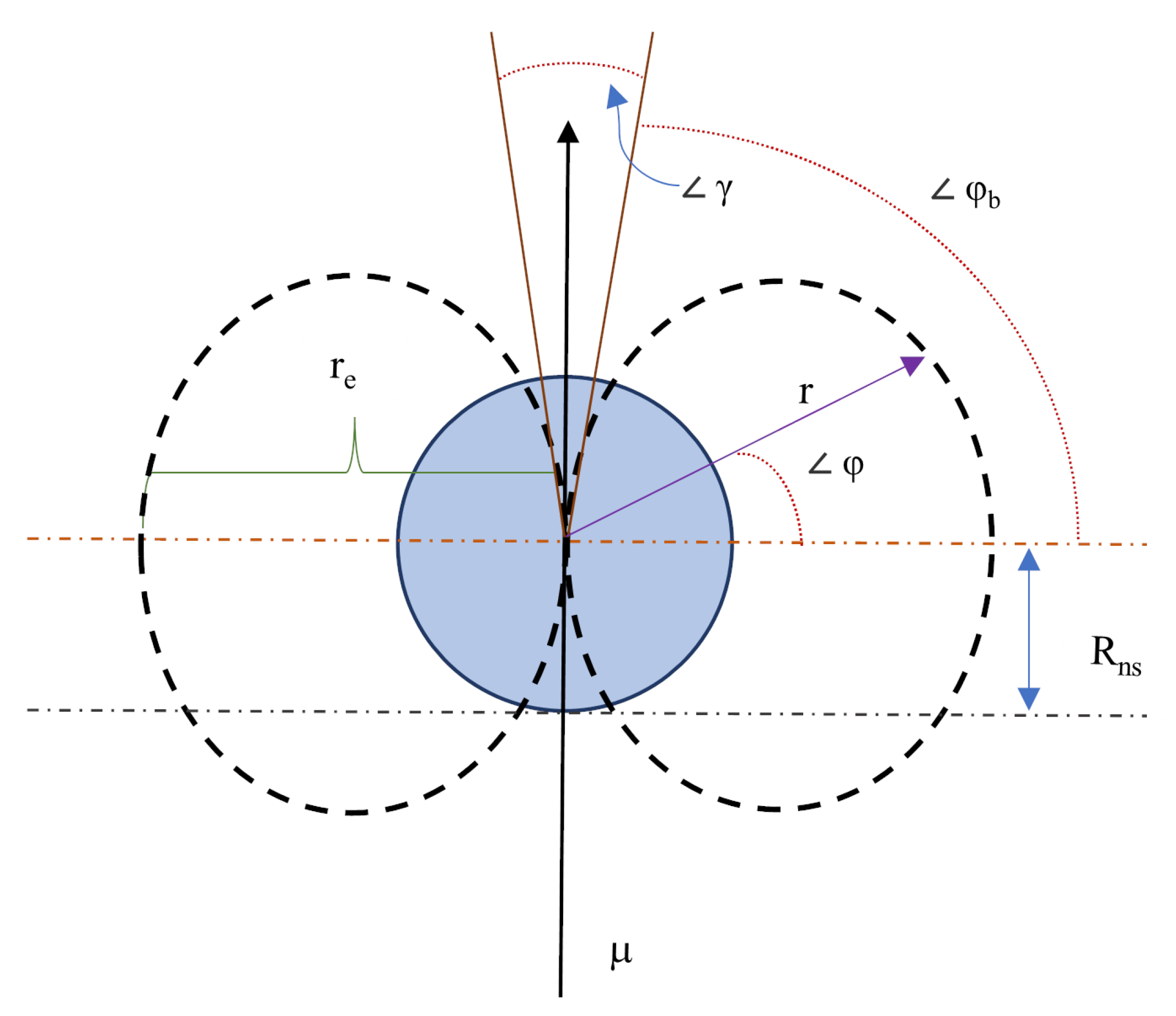
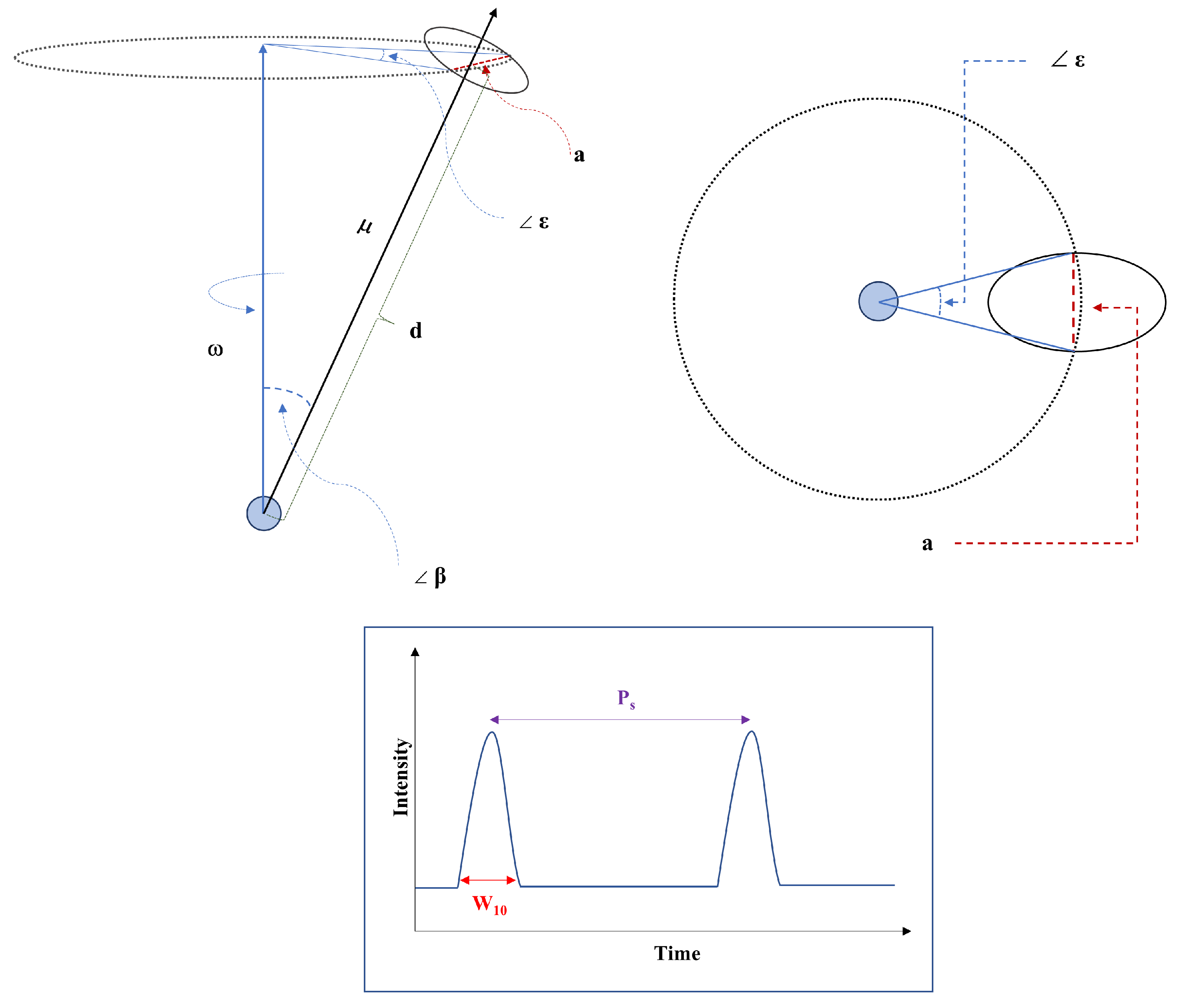
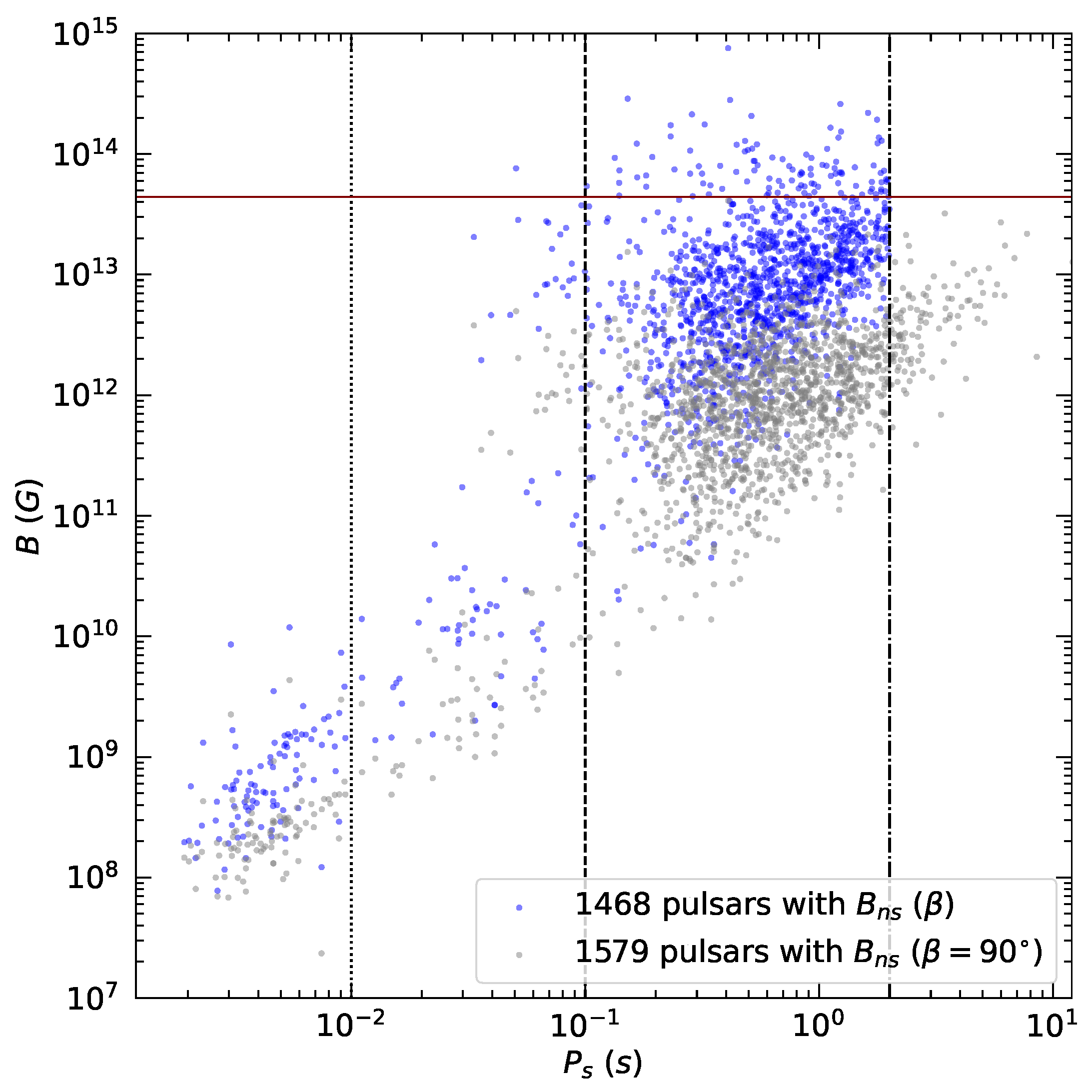
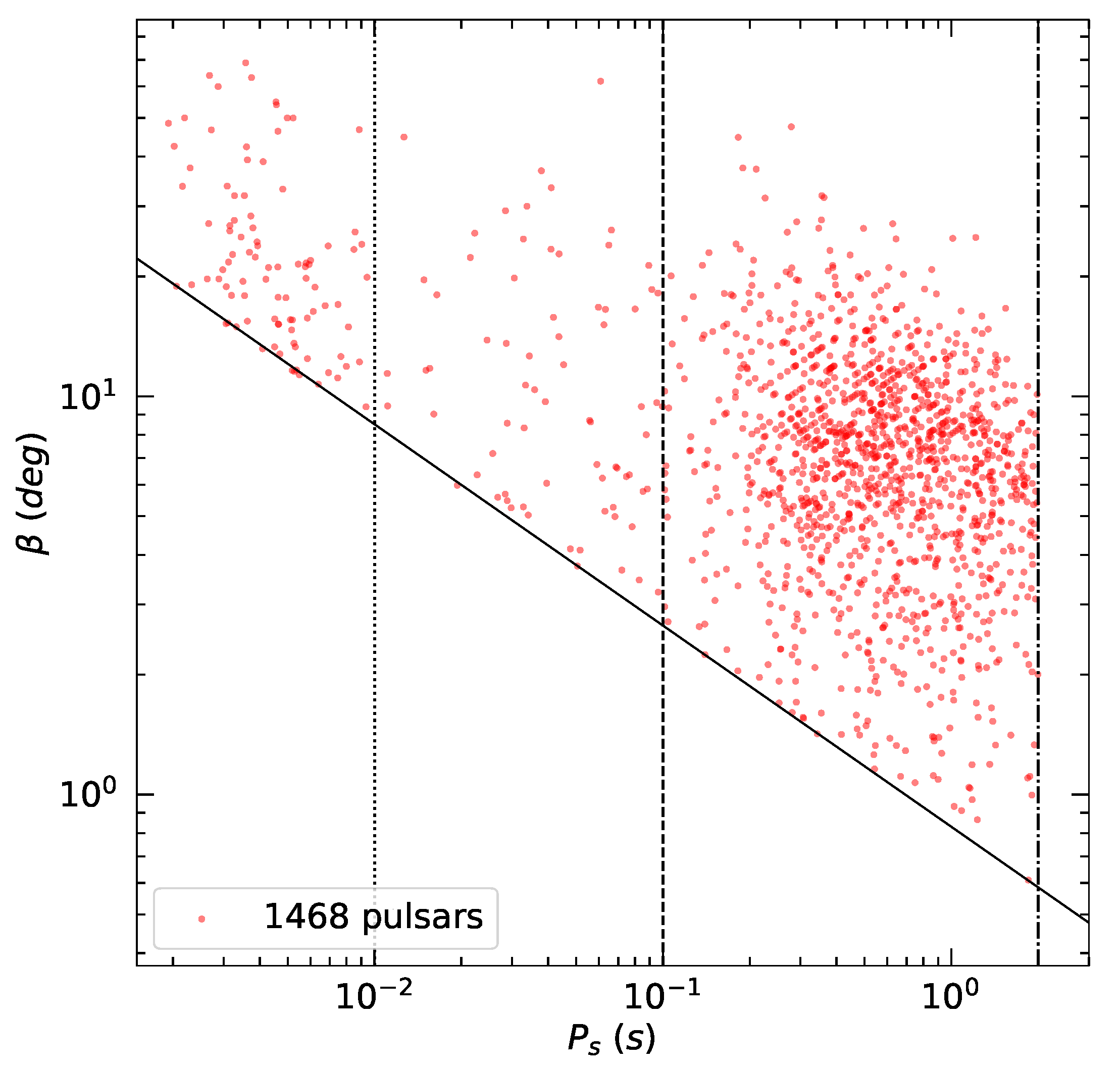
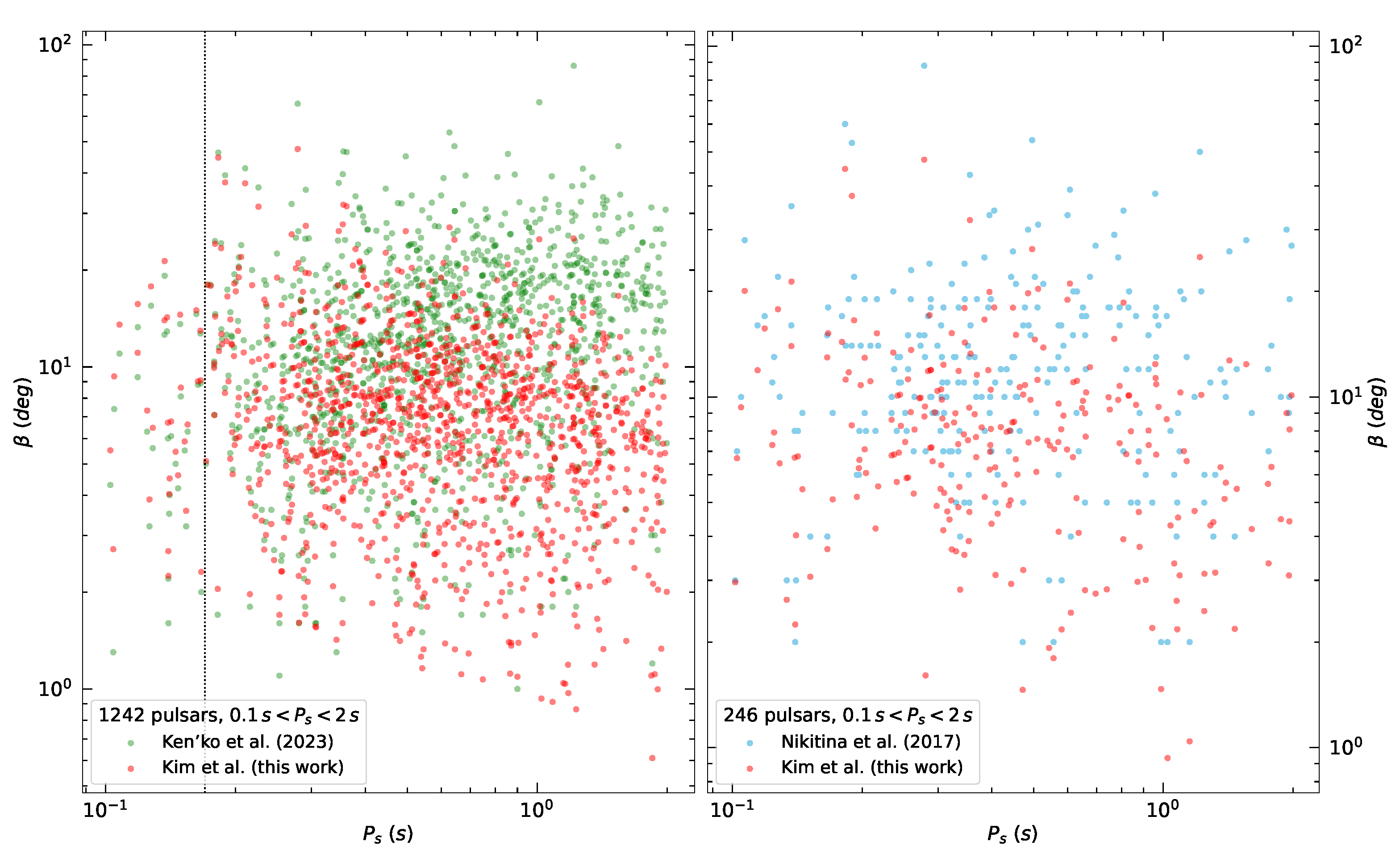
| No. | Name | RA | DEC | |||||
|---|---|---|---|---|---|---|---|---|
| PSR | J2000 | J2000 | (s) | (s/s) | (ms) | (deg) | ( G) | |
| 1 | J0006+1834 | 00:06:04.8 | +18:34:59.0 | 0.69 | 2.10e-15 | 195.0 | 1.29 | 54.3 |
| 2 | B0011+47 | 00:14:17.7 | +47:46:33.4 | 1.24 | 5.64e-16 | 142.5 | 2.11 | 23 |
| 3 | J0026+6320 | 00:26:50.5 | +63:20:00.8 | 0.32 | 1.51e-16 | 48.0 | 3.22 | 3.94 |
| 4 | B0031-07 | 00:34:08.8 | −07:21:53.4 | 0.94 | 4.08e-16 | 120.0 | 2.20 | 16.4 |
| 5 | J0038-2501 | 00:38:10.2 | −25:01:30.7 | 0.26 | 7.60e-19 | 15.0 | 9.01 | 0.093 |
| ... | ... | ... | ... | ... | ... | ... | ... | ... |
| Puls. Group | Min | Max | Mean | Median | Total | |
|---|---|---|---|---|---|---|
| 9.41 | 68.78 | 25.15 | 20.92 | 13.93 | 94 | |
| 3.22 | 61.84 | 13.33 | 9.46 | 10.51 | 73 | |
| 0.61 | 47.51 | 7.83 | 6.98 | 4.99 | 1301 | |
| All | 0.61 | 68.78 | 9.21 | 7.43 | 7.65 | 1468 |
| Puls. Group | Total | |||||
|---|---|---|---|---|---|---|
| 7.76 × 107 | 1.19 × 1010 | 1.92 × 109 | 5.75 × 108 | 1.68 × 109 | 94 | |
| 1.38 × 109 | 7.62 × 1013 | 5.28 × 1012 | 2.96 × 1010 | 1.18 × 1013 | 73 | |
| 2.19 × 1010 | 7.56 × 1014 | 1.69 × 1013 | 8.33 × 1012 | 3.39 × 1013 | 1301 | |
| All | 7.76 × 107 | 7.56 × 1014 | 1.53 × 1013 | 7.1 × 1012 | 3.24 × 1013 | 1468 |
| Pulsar Sample | Selection Criteria | Pulsar Number | Min | Max | Mean | Median | |
|---|---|---|---|---|---|---|---|
| Ken’ko et al. (2023) [5] | , | 1242 | |||||
| Nikitina et al. (2017) [22] | , , | 246 |
| No. | Name | |||
|---|---|---|---|---|
| PSR | (deg) | (deg) | (deg) | |
| 1 | J0108-1431 | 3.93 | 11 | 7.07 |
| 2 | B0656+14 | 5.18 | 17 | 11.82 |
| 3 | J0905-5127 | 14.30 | 22 | 7.70 |
| 4 | J1015-5719 | 2.25 | 5 | 2.75 |
| 5 | B1055-52 | 6.62 | 15 | 8.38 |
| 6 | J1349-6130 | 9.05 | 64 | 54.95 |
| 7 | J1355-5925 | 6.49 | 10 | 3.51 |
| 8 | B1509-58 | 3.07 | 10 | 6.93 |
| 9 | B1702-19 | 10.41 | 49 | 38.59 |
| 10 | J1702-4310 | 5.73 | 11 | 5.27 |
| 11 | J1723-3659 | 17.96 | 28 | 10.04 |
| 12 | B1800-21 | 2.64 | 12 | 9.36 |
| 13 | B1822-14 | 5.07 | 8 | 2.93 |
Disclaimer/Publisher’s Note: The statements, opinions and data contained in all publications are solely those of the individual author(s) and contributor(s) and not of MDPI and/or the editor(s). MDPI and/or the editor(s) disclaim responsibility for any injury to people or property resulting from any ideas, methods, instructions or products referred to in the content. |
© 2023 by the authors. Licensee MDPI, Basel, Switzerland. This article is an open access article distributed under the terms and conditions of the Creative Commons Attribution (CC BY) license (https://creativecommons.org/licenses/by/4.0/).
Share and Cite
Kim, V.; Umirbayeva, A.; Aimuratov, Y. Estimates of the Surface Magnetic Field Strength of Radio Pulsars. Universe 2023, 9, 334. https://doi.org/10.3390/universe9070334
Kim V, Umirbayeva A, Aimuratov Y. Estimates of the Surface Magnetic Field Strength of Radio Pulsars. Universe. 2023; 9(7):334. https://doi.org/10.3390/universe9070334
Chicago/Turabian StyleKim, Vitaliy, Adel Umirbayeva, and Yerlan Aimuratov. 2023. "Estimates of the Surface Magnetic Field Strength of Radio Pulsars" Universe 9, no. 7: 334. https://doi.org/10.3390/universe9070334
APA StyleKim, V., Umirbayeva, A., & Aimuratov, Y. (2023). Estimates of the Surface Magnetic Field Strength of Radio Pulsars. Universe, 9(7), 334. https://doi.org/10.3390/universe9070334







